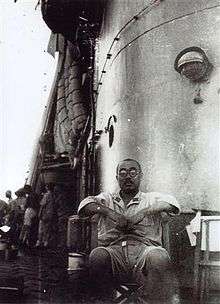Shunsaku Kudō
| Shunsaku Kudō | |
|---|---|
 | |
| Born |
January 7, 1901 Higashiokitama District, Yamagata, Japan |
| Died |
January 12, 1979 (aged 78) Kawaguchi, Saitama, Japan |
| Allegiance |
|
| Service/branch |
|
| Years of service | 1923–1945 |
| Rank | Commander |
| Unit | Combined Fleet |
| Commands held |
Hatakaze Ikazuchi Hatsuharu Hibiki |
Commander Shunsaku Kudō (工藤 俊作 Kudō Shunsaku, January 7, 1901 – January 12, 1979) was an officer in the Imperial Japanese Navy. He is notable for the humanitarian act of rescuing 442 enemy British and American sailors from the Java Sea in 1942.
Biography
Born in 1901, Kudō graduated from the Imperial Japanese Naval Academy in 1923 and was assigned to the light cruiser Yubari as a midshipman, followed by the battleship Nagato in October 1924. He was commissioned in December 1924, was promoted to the rank of Second Lieutenant in 1926, and took his first command, the destroyer Hatakaze, in 1929. He assumed command of Ikazuchi in November 1940.
Rescue of 442 enemy sailors
On March 2, 1942, Lieutenant Commander Kudō ordered Ikazuchi to rescue 442 survivors from the Royal Navy destroyer HMS Encounter and United States Navy destroyer USS Pope. These ships had been sunk the previous day, along with HMS Exeter, in the Java Sea between Java and Borneo, off the Indonesian port of Soerabaja. The survivors had been adrift for some 20 hours, in rafts and lifejackets or clinging to floats, many coated in oil and unable to see. Among the rescued was Sir Sam Falle, later a British diplomat.[1] This humanitarian decision by Lieutenant Commander Kudō placed the Ikazuchi at risk of submarine attack, and interfered with her fighting ability due to the sheer numbers of rescued sailors. The action was later the subject of books[2][3][4] and a 2007 TV programme.[5][6][7] According to the same documentary, humility and sadness sealed Kudō Shunsaku's lips after Ikazuchi was sunk with all its crew, thus he never told anyone about this heroic rescue.
Post-war life
After the war, Kudō left the navy and moved to Kawaguchi, Saitama. In 1979, he died of stomach cancer.
References
- ↑ BBC News (2003-06-13), Reunion for sailor saved by enemy, BBC News Online, retrieved 2008-06-29
- ↑ Megumi, Ryuunosuke (2006-07-05), 敵兵を救助せよ!—英国兵422名を救助した駆逐艦「雷」工藤艦長, Tokyo, Japan: Soshisha Publishing Company, ISBN 978-4-7942-1499-7
- ↑ hisashi (2007-05-21), Kudo Shunsaku and the Destroyer Ikazuchi, retrieved 2008-06-29. This forum discussion contains a brief summary of the 2006 Megumi book's account of the HMS Encounter and USS Pope rescues.
- ↑ Sam Falle, My Lucky Life: In War, Revolution, Peace and Diplomacy, Book Guild Ltd, 29.08.1996
- ↑ The Untold story of Captain Kudo Shunsaku and the Destroyer Ikazuchi, 2007-05-19, retrieved 2008-06-29
|first1=missing|last1=in Authors list (help) - ↑ gyokai (2007). 日本の武士道1 Japanese BUSIDO saved lives (video). YouTube. Retrieved 2008-06-29. In Japanese. See also part 2 on YouTube and part 3 on YouTube.
- ↑ 伊勢, 雅臣 (2006-08-13), 駆逐艦「雷」艦長・工藤俊作 (in Japanese), retrieved 2008-06-29. In Japanese. A summary of the 2007 television program.